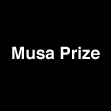


|

|
 This is the guide for the participants distributed for the 1996 Musa Prize. |
The purpose of the MUSA award is to stimulate potential new multimedia authors
to test their own ability in creating synergies between text, images, video-
and sound-clips. For what concerns art. 3B. 1 of the call --"Title and
description/summary of the work", definition of "the kind of interactivity"
(navigation, consultation), of the "purpose" and the "target" one intends to
address with one's own products--, we advise to produce maximum three
typewritten pages. Under headword "the kind of interactivity", one should make textually explicit the way through which the final reader of the title will be able to interact with the new product. One should indicate if the use of the keyboard, the mouse or the touchscreen is expected. Remember also that the "target" of the work is a fundamental point which authors have to make clear together with the purpose of their own multimedia product. We advise to analyse the type and level of users the work will be addressed to. It is particularly relevant, in fact, that authors apart from the optimal size of the works consider the most suited perspective to adopt according to the user they are addressing.
N.B. The advices concerning the organisation of material given subsequently in this guide are mere indications: any other type of organisation of the material will be considered valid and be anyway examined, provided that the author indicates the way of reading the contents of the work and the forwarded material. Remember also that the works will be evaluated on an originality basis of the ideas and not on the amount of the forwarded material.
Preparation of the material
1. THE TEXTS We advise to use a clear language, sentences should be of simple construction, avoiding advancing styles. Preparation of the text It is necessary that the text should be usable: it should not be longwinded in order to avoid difficult reading. For the realisation of the texts, we advise the use of synthetic and easy to memorise key concepts. Graphics should not contain too long legends. Preparation of the comment
Musical comment: if possible, avoid songs and too well-known music.
2. THE IMAGES (and any other audiovisual information) It is easier for human memory to remember images rather than texts, that's the reason why the former should be the cornerstone around which the latter are built. It would be appropriate to associate at every point of one's own work some graphics, a sound-clip or a video-clip. For the choice of images it is better to keep in mind the collective cultural level of the user one's own work is addressing. Determine and write the selected images for every screen. Note on every form the multimedia bibliography of these images --mention author, title, copyright and origins etc. If you own them, please send them even in a copy or photocopy. Remember that the committee will especially consider the completeness in mentioning the owners of the copyrights of the images, films, musical and sound comments and that the failing of such information could also lead to the exclusion of the work from the competition.
3. THE STORYBOARD That is, a designed script. One has to create a setting to realise the navigational system. What has been described before (texts, comments, graphics, images, sound etc.) will have to be put together to write the setting. Screenform For every screen the following will have to be indicated: 1) which text or video will be visualised 2) which verbal or musical comment will accompany the chart 3) which images will be represented 4) the copyright owners of the above listed We advise to produce a paper form for every screen on which all details of points 1,2,3 and 4 will be indicated. Map of connections between forms That is to say the visualisation of the structure of the work and the hypothetical hypertextual links between the various forms of the screens Index of the forms We advice to fill in a sequential index with all the titles of the forms mentioned in points 1,2,3 and 4 so that to offer an overview of the contents.
4. WHAT IS NOT ASKED FROM THE AUTHOR Apart from a brief description of the type of interactivity, the author is not asked to realise a software product that practically demonstrates the ways of interaction the product will have with the user and thus to fully formulate the type of interface, the presence of pre-defined paths, the ways of representing the links, the ways of presenting the texts and the images, and in general any form of presentation addressed to the reader. Anyway, even though it is not compulsory to produce any lay-out or graphic project, or to push oneself into the following technical realisation, the applicant can supply the work with a product that presents the kind of the proposed interfaces. |
ph. +39 41 2601700 fax +39 41 5223051 - email: iltridente@tin.it |